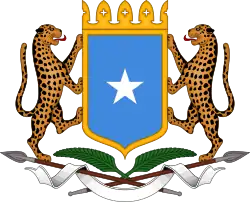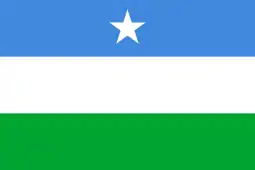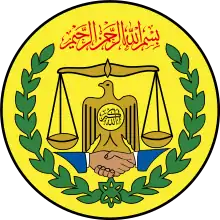Somali Civil War
The Somali Civil War (Somali: Dagaalkii Sokeeye ee Soomaaliya, Arabic: الحرب الأهلية الصومالية) is an ongoing civil war which is taking place in Somalia. It grew out of resistance to the military junta which was led by Siad Barre during the 1980s. From 1988–1990, the Somali Armed Forces began engaging in combat against various armed rebel groups,[18] including the Somali Salvation Democratic Front in the northeast,[19] the Somali National Movement in the northwest,[18] and the United Somali Congress in the south.[20] The clan-based armed opposition groups overthrew the Barre government in 1991.[21]
Various armed factions began competing for influence in the power vacuum and turmoil that followed, particularly in the south.[22] In 1990–92, customary law temporarily collapsed due to the fighting.[23] This precipitated the arrival of UNOSOM I UN military observers in July 1992, followed by larger peacekeeping forces. Factional fighting continued in the south. In the absence of a central government, Somalia became a "failed state".[24] The UN withdrew in 1995, having incurred large casualties and the UN-created police force collapsed.[22] After the central government's collapse, there was some return to customary and religious law in most regions.[25] In 1991 and 1998, two autonomous regional governments were also established in the northern part of the country.[22] This led to a relative decrease in the intensity of the fighting, with the Stockholm International Peace Research Institute removing Somalia from its list of major armed conflicts for 1997 and 1998.[26]
In 2000, the Transitional National Government was established, followed by the Transitional Federal Government (TFG) in 2004. The trend toward reduced conflict halted in 2005, and sustained and destructive conflict took place in the south in 2005–07,[27] but the battle was of a much lower scale and intensity than in the early 1990s.[26] In 2006, Ethiopian troops seized most of the south from the newly formed Islamic Courts Union (ICU). The ICU then splintered into more radical groups, notably Al-Shabaab, which have since been fighting the Somali government and the AU-mandated AMISOM peacekeeping force for control of the country. Somalia topped the annual Fragile States Index for six years from 2008 up to and including 2013.[28]
In October 2011, following preparatory meetings, Kenyan troops entered southern Somalia ("Operation Linda Nchi") to fight Al-Shabaab[29] and establish a buffer zone inside Somalia.[30] Kenyan troops were formally integrated into the multinational force in February 2012.[31] The Federal Government of Somalia was established in August 2012, constituting the country's first permanent central government since the start of the civil war.[32] International stakeholders and analysts subsequently began to describe Somalia as a "fragile state" that is making some progress toward stability.[33][34][35][36]
Fall of Siad Barre's government (1978–91)
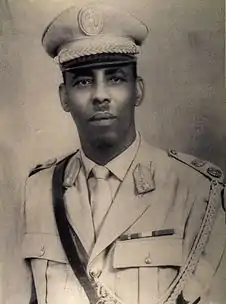
After Somalia lost the Ogaden war in March 1978, the president's popularity with the Somali people plummeted and widespread discontent among his generals led to an attempted coup d'état on the 10 of April 1978.
Most of the coup's ringleaders were rounded up and executed but some escaped and formed the Somali Salvation Democratic Front, starting the rebellion that eventually toppled Siad Barre from power 13 years later.
In May 1986, Mohamed Siad Barre suffered serious injuries in a car crash near Mogadishu, when the car transporting him smashed into the back of a bus during a heavy rainstorm.[37] He was treated in a hospital in Saudi Arabia for head injuries, broken ribs and shock for a month.[38][39] Lieutenant General Mohamed Ali Samatar, then Vice President, served as de facto head of state for the next several months. Although Barre managed to recover enough to present himself for reelection to a seven-year term on December 23, 1986, his poor health and advanced age led to speculation about who would succeed him. Possible contenders included his son-in-law General Ahmed Suleiman Abdille, then the Minister of the Interior, in addition to Samatar.[37][38]
In an effort to hold on to power, Barre's ruling Supreme Revolutionary Council (SRC) became increasingly totalitarian and arbitrary. This caused opposition to his government to grow. Barre tried to quell the unrest by abandoning appeals to nationalism, relying more and more on his own inner circle, and exploiting historical clan animosities. By the mid-1980s, more resistance movements supported by Ethiopia's communist Derg administration had sprung up across the country. Barre responded by ordering punitive measures against those he perceived as supporting the guerrillas, especially in the north. The clampdown included bombing of cities, with the northwestern administrative center of Hargeisa, a Somali National Movement (SNM) stronghold, among the targeted areas in 1988.[40]
In December 1981, unrest was triggered in Northern Somalia by the arrest of 30 Isaaq professionals in Hargeisa who created a self-help group to improve local facilities.[41] This was followed by the systematic efforts to remove all Isaaqs from positions of power including the military, judiciary and security services. The transfer of power to non-Isaaq pro-government individuals further pushed Isaaq communities to rebel against Barre's regime.[41]
In 1988, Siad Barre and Ethiopian dictator Mengistu agreed to a secret deal whereby each would cease hosting insurgencies of one another.[42] As a result, prompting the Somali National Movement (SNM) to launch an offensive on Northern Somalia from its bases on the Ethiopian border.[43] Barre's regime responded with “systematic” human rights abuses and the genocide of thousands of Isaaq tribesmen resulting in up to 200,000 civilians slaughtered and 500,000 more people seeking refuge in neighbouring Ethiopia.[43]
Soon after, Western aid donors cut funding to the Somali regime which was heavily reliant on foreign aid in response to these humanitarian abuses.[43] As a result, there was rapid "retreat of the state" accompanied with the value of the Somali Shilling taking a nosedive and mass desertion of Somali army units from the military.[43]
In 1990, as fighting intensified, Somalia's first President, Aden Abdullah Osman Daar, and about 100 other Somali politicians signed a manifesto advocating reconciliation.[44] A number of the signatories were subsequently arrested.[45] Barre's heavy-handed tactics further strengthened the appeal of the various rebel movements, although these groups' only common goal was the overthrow of his government.[40] It also played a major role in developing piracy in Somalia.
In the north, fighting continued between SNM rebels and heavily armed pro-government militia in places like Awdal.[46] In January 1991, in one of the final episodes of the civil war in the north, SNM militia gave chase to retreating government forces (26th division) to the town of Dilla, where a battle took place and the town was destroyed.[47] SNM militia then continued into Borama, the capital and largest town of Awdal, but the SNM leadership withdrew units within 24 hours to allow discussions to take place without the threat of occupation.[48] By February 4, SNM's control extended to the entire north of Somalia, and all prisoners and pro-government ex-soldiers were released and ordered to return to their regions of origin (mainly Ethiopia), except for Hawiye ex-soldiers and ex-civil servants, who were permitted to remain in Burco since their lives would have been at risk if they had traveled through hostile pro-Barre country on their return to Mogadishu.[49]
United Somali Congress topples Barre

By mid-1990, United Somali Congress (USC) rebels had captured most towns and villages surrounding Mogadishu, which prompted some to give Barre the ironic title 'Mayor of Mogadishu.'[50] In December the USC entered Mogadishu. Four weeks of battle between Barre's remaining troops and the USC ensued, during which the USC brought more forces into the city. By January 1991, USC rebels defeated the Red Berets in the process toppling Barre's government.[40] The remainder of the government's forces then finally collapsed. Some became irregular regional forces and clan militias.[51] After the USC's victory over Barre's troops, the other rebel groups declined to cooperate with it, as each instead drew primary support from its own constituency.[40] Among these other opposition movements were the Somali Patriotic Movement (SPM) and Somali Democratic Alliance (SDA), a Gadabuursi group which had been formed in the northwest to counter the Somali National Movement Isaaq militia.[52] For its part, the SNM initially refused to accept the legitimacy of the provisional government that the USC had established,[40] but in March 1991 the SNM's former leader Ahmed Mohamed Silanyo proposed a power-sharing framework between the SNM and USC under a new transitional government.[53]
Many of the opposition groups subsequently began competing for influence in the power vacuum that followed the ousting of Barre's government. In the south, armed factions led by USC commanders General Mohamed Farah Aidid and Ali Mahdi Mohamed, in particular, clashed as each sought to exert authority over the capital.[54]
In the northwest, at the Burao conference of April–May 1991, the SNM declared an independent Republic of Somaliland in the region that had constituted the British Somaliland before independence and unification with the former colony of Italian Somaliland in 1960 [55] electing Abdirahman Ahmed Ali Tuur as president.[56]
In 1992, after four months of heavy fighting for control of Mogadishu, a ceasefire was agreed between Ali Mahdi Mohamed and Mohamed Farah Aideed. Neither had seized control of the capital, and as a result, a 'greenline' was established between north and south that divided their areas of control.[57]
United Nations intervention (1992–1995)
UN Security Council Resolution 733 and UN Security Council Resolution 746 led to the creation of the United Nations Operation in Somalia I (UNOSOM I), to provide humanitarian relief and help restore order in Somalia after the dissolution of its central government.
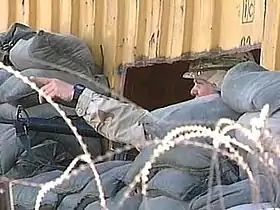
United Nations Security Council Resolution 794 was unanimously passed on December 3, 1992, which approved a coalition of United Nations peacekeepers led by the United States. Forming the Unified Task Force (UNITAF), the alliance was tasked with assuring security until humanitarian efforts aimed at stabilizing the situation were transferred to the UN. Landing in 1993, the UN peacekeeping coalition started the two-year United Nations Operation in Somalia II (UNOSOM II) primarily in the south.[58] UNITAF's original mandate was to use "all necessary means" to guarantee the delivery of humanitarian aid in accordance to Chapter VII of the United Nations Charter.[59]
During negotiations from 1993 to 1995, Somali principals had some success in reconciliation and establishment of public authorities. Among these initiatives was the Mudug peace agreement of June 1993 between Aidid's forces and the SSDF, which established a ceasefire between the Haber Gedir and the Majeerteen clans, opened the trade routes, and formalized the withdrawal of militants from Galkayo; the UNOSOM-mediated Hirab reconciliation of January 1994 in Mogadishu between elders of the rival Abgal and Haber Gedir clans, which was backed by politicians from these constituencies and concluded with a pact to end hostilities, dismantle the green line partitioning the city, and remove road blocks; the UNOSOM-mediated Kismayo initiative of 1994 between the SNA, SPM, SSDF, and representatives of nineteen clans from the southern Lower Juba and Middle Juba regions;[60] the 1994 Bardhere conference between the Marehan and Rahanweyn (Digil and Mirifle), which resolved conflicts over local resources; and the short-lived Digil-Mirifle Governing Council for the southern Bay and Bakool regions, which was established in March 1995.[55]
Some of the militias that were then competing for power saw UNOSOM's presence as a threat to their hegemony. Consequently, gun battles took place in Mogadishu between local gunmen and peacekeepers. Among these was the Battle of Mogadishu in October 1993, an unsuccessful attempt by U.S. troops to apprehend faction leader Aidid. UN soldiers eventually withdrew altogether from the country on March 3, 1995, having incurred more significant casualties.[61]
USC/SSA (1995–2000)
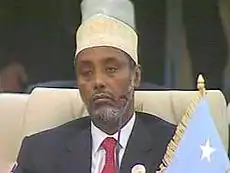
According to Interpeace, after UNOSOM's departure in March 1995, military clashes between local factions became shorter, generally less intense, and more localized. This was in part due to the large-scale UN military intervention that had helped to curb the intense fighting between the major factions, who then began to focus on consolidating gains that they had made. The local peace and reconciliation initiatives that had been undertaken in the south-central part of the country between 1993 and 1995 also generally had a positive impact.[55]
Aidid subsequently declared himself President of Somalia on June 15, 1995.[62] However, his declaration received no recognition, as his rival Ali Mahdi Muhammad had already been elected interim President at a conference in Djibouti and recognized as such by the international community.[63]
Consequently, Aidid's faction continued its quest for hegemony in the south. In September 1995, militia forces loyal to him attacked and occupied the city of Baidoa.[64] Aidid's forces remained in control of Baidoa from September 1995 to at least January 1996, while the local Rahanweyn Resistance Army militia continued to engage his forces in the town's environs.[65]
Fighting continued in the later half of 1995 in southern Kismayo and the Juba Valley, as well as southwestern and central Somalia. However, despite these pockets of conflict, the Gedo and Middle Shabelle regions, in addition to both the northeastern and northwestern parts of the country remained relatively peaceful. A number of the regional and district administrations that had been locally established in the preceding few years continued to operate in these areas.[65]
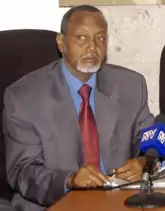
In March 1996, Ali Mahdi was elected chairman of the United Somali Congress/Somali Salvation Alliance (USC/SSA), based in northern Mogadishu. In the southern part of city, Aidid's forces battled those of Osman Atto for control of the port of Merca as well as strategic areas in Mogadishu. Fighting in Merca eventually ended after elders intervened, but continued in Mogadishu. In August 1996, Aidid died from wounds incurred during combat in the Medina area.[66]
In 1998, a homegrown constitutional conference was held in the northeastern town of Garowe over a period of three months. Attended by the area's political elite, traditional elders (Issims), members of the business community, intellectuals and other civil society representatives, the autonomous Puntland State of Somalia was subsequently officially established so as to deliver services to the population, offer security, facilitate trade, and interact with both domestic and international partners.[67]
In 1999, Eritrea was alleged to be supporting Somali National Alliance forces led by the late Aidid's son Hussein Farrah Aidid. Aidid Jr. denied the claims, saying that the Ethiopian Prime Minister Meles Zenawi had requested that he mediate between Ethiopia and Eritrea in their separate conflict.[68] However the International Institute for Strategic Studies separately reported that Hussein Aideed himself had acknowledged support from both Eritrea and Uganda.[69] Aideed's forces occupied Baidoa in May 1999. However they were driven out by the Rahanweyn Resistance Army in June 1999, backed by an Ethiopian force of up to 3,000 using tanks and artillery. The IISS said that the attack was part of a strategy to prevent Eritrea opening up a new front. By the end of the year, the Rahanweyn Resistance Army had taken control of the southern Bay and Bakool provinces. The RRA's leader Hasan Muhammad Nur Shatigadud subsequently established the Southwestern State of Somalia regional administration.
In 2000, Ali Mahdi participated in another conference in Djibouti. He lost a re-election bid there to Barre's former Interior Minister Abdiqasim Salad Hassan.[70]
TFG, Islamic Courts Union, and Ethiopia (2006–2009)
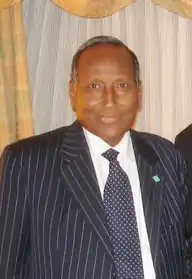
In 2000, the Transitional National Government (TNG) was established.[21] The Transitional Federal Government (TFG) was formed in Nairobi in 2004. Selection of members of parliament was underway by June, over two hundred members of parliament (MPs) took the oath of office in August, and Abdullahi Yusuf Ahmed was elected president by the parliament in October 2004.[71] However, in March 2005 the TFG split after a brawl in parliament over deployment of peacekeepers and relocation to an interim capital. The parliamentary speaker led some members to Mogadishu while the president and others remained in Nairobi. In June 2005, under pressure from Kenya, the remainder of the TFG left Nairobi for Jowhar.[72] In February 2006, the TFG parliament met in Baidoa for the first time since March 2005. (Interpeace, 104)
A battle for Mogadishu followed in the first half of 2006 in which the ARPCT, a coalition of U.S.-backed militia leaders, confronted the ascendant Islamic Courts Union (ICU). However, the ICU won a decisive victory in June of that year.[73] It then rapidly expanded and consolidated its power throughout southern Somalia. By August 2006, the TFG was confined to Baidoa under Ethiopian protection. (Interpeace, 104)
In December 2006, Ethiopian troops entered Somalia to assist the TFG against the advancing Islamic Courts Union,[21] initially winning the Battle of Baidoa. With their support, Somali government forces recaptured the capital from the ICU.[74] The offensive helped the TFG solidify its rule.[73] On January 8, 2007, as the Battle of Ras Kamboni raged, TFG President and founder Abdullahi Yusuf Ahmed entered Mogadishu for the first time since being elected to office. But as Meckhaus writes, the TFG was seen "by most of the Mogadishu population as a puppet of Ethiopia, and uncontrolled TFG security forces became the principal sources of insecurity for the local population, engaging in kidnapping, assaults, and worse."[75] Within weeks, an armed insurgency subsequently arose in the capital against the TFG and its Ethiopian allies. The government then relocated to the capital from its interim location in Baidoa.[74]
The arms embargo on Somalia was amended in February 2007 to allow states to supply weapons to the TFG's security forces, provided that they received prior approval from the UN's Somalia Sanctions Committee. After long discussions, the African Union approved the initial deployment of the African Union Mission to Somalia (AMISOM) in March 2007. It established a "small triangle of protection" around Mogadishu's airport, seaport, and the Villa Somalia, and began to adopt a low-key negotiating profile with key actors.[76] In November 2008, following repeated violations of the weapons blockade, the Security Council decided that an arms embargo could be imposed on entities involved in such breaches.[77] After a two-year consultation process, the TFG was formed in 2004 by Somali politicians in Nairobi under the auspices of the Intergovernmental Authority on Development (IGAD). The process also led to the establishment of the Transitional Federal Institutions (TFIs), and concluded in October 2004 with the election of Abdullahi Yusuf Ahmed as president.[78] The TFG thereafter became Somalia's internationally recognized government.[77]
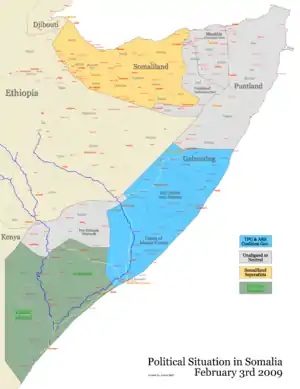
Following their defeat, the Islamic Courts Union splintered into several different factions. Some of the more radical elements, including Al-Shabaab, regrouped to continue their insurgency against the TFG and oppose the Ethiopian military's presence in Somalia.[79] Throughout 2007 and 2008, Al-Shabaab scored military victories, seizing control of key towns and ports in both central and southern Somalia. At the end of 2008, the group had captured Baidoa but not Mogadishu. On May 1, 2008, the U.S. made an airstrike on Dhusamareb, and followed on 3 May with another airstrike on the border town of Dobley. According to the International Crisis Group, Ethiopia's leaders were surprised by the insurgency's persistence and strength and frustrated at the TFG's chronic internal problems.[80] By January 2009, Al-Shabaab and other militias had forced the Ethiopian troops to retreat, leaving behind an understaffed African Union peacekeeping force.[81]
Due to a lack of funding and human resources, an arms embargo that made it difficult to re-establish a national security force, and general indifference on the part of the international community, President Yusuf found himself obliged to deploy thousands of troops from Puntland to Mogadishu to sustain the battle against insurgent elements in the southern part of the country. Financial support for this effort was provided by the autonomous region's government. This left little revenue for Puntland's own security forces and civil service employees, leaving the territory vulnerable to piracy and terrorist attacks.[82][83]
On December 29, 2008, Abdullahi Yusuf Ahmed announced before a united parliament in Baidoa his resignation as President of Somalia. In his speech, which was broadcast on national radio, Yusuf expressed regret at failing to end the country's seventeen-year conflict as his government had mandated to do.[84] He also blamed the international community for its failure to support the government, and said that the speaker of parliament would succeed him in office per the charter of the Transitional Federal Government.[85]
Coalition government (2009–present)

Between May 31 and June 9, 2008, representatives of Somalia's federal government and the Alliance for the Re-liberation of Somalia (ARS) participated in peace talks in Djibouti brokered by the former United Nations Special Envoy to Somalia, Ahmedou Ould-Abdallah. The conference ended with a signed agreement calling for the withdrawal of Ethiopian troops in exchange for the cessation of armed confrontation. Parliament was subsequently expanded to 550 seats to accommodate ARS members, which then elected Sheikh Sharif Sheikh Ahmed, the former ARS chairman, to office. President Sharif shortly afterwards appointed Omar Abdirashid Ali Sharmarke, the son of slain former President Abdirashid Ali Sharmarke, as the nation's new Prime Minister.[21]
With the help of AMISOM, the coalition government also began a counteroffensive in February 2009 to assume full control of the southern half of the country. To solidify its rule, the TFG formed an alliance with the Islamic Courts Union, other members of the Alliance for the Re-liberation of Somalia, and Ahlu Sunna Waljama'a, a moderate Sufi militia.[86] Furthermore, Al-Shabaab and Hizbul Islam, the two main Islamist groups in opposition, began to fight amongst themselves in mid-2009.[87]
As a truce, in March 2009, Somalia's coalition government announced that it would re-implement shari'a as the nation's official judicial system.[88] However, conflict continued in the southern and central parts of the country. Within months, the coalition government had gone from holding about 70% of south-central Somalia's conflict zones, territory which it had inherited from the previous Yusuf administration, to losing control of over 80% of the disputed territory to the Islamist insurgents.[89]
Since 2009
In November 2010, a new technocratic government was elected to office, which enacted numerous reforms. Among these, in its first 50 days in office, the new administration completed its first monthly payment of stipends to government soldiers.[90]
On August 6, 2011, Al-Shabaab was forced to withdraw from most of Mogadishu. Somali government forces and their AMISOM allies subsequently launched offensives in January 2012 on its last foothold, in the city's northern outskirts.[91] An ideological rift within Al-Shabaab's leadership also emerged after the 2011 drought and the assassination of top officials in the organization.[92]
In October 2011, following a weekend preparatory meeting between Somali and Kenyan military officials in Dhobley,[93] Operation Linda Nchi, involving the Kenya Defence Forces and Somali Armed Forces, began against Al-Shabaab in southern Somalia.[94][95] The cross-border incursion reportedly took nearly two years of planning, during which Kenyan officials sought U.S. support.[96][97] In early June 2012, Kenyan troops were formally integrated into AMISOM.[98]
In late September and early October 2012, Kenya Army AMISOM troops, and the allied Raskamboni militia captured the strategic town of Kismayo from Al-Shabaab. The southern city was one of its key sources of revenue and its last major stronghold.[99]
The Federal Government of Somalia was established in September 2012 (Bryden, Somalia Redux).
In January 2013, AMISOM's mandate was extended for another year following the adoption of UNSC Resolution 2093. The Security Council also unanimously voted to suspend Somalia's arms embargo on light weapons for one year and welcomed the Federal Government's development of a new national security strategy, urging the central authorities to accelerate the plan's implementation, further define the Somali national security forces' composition, and identify capability gaps to assist their international partners in better addressing them.[100] While many urban areas had been seized, Al-Shabaab still controlled many rural areas, where a number of their operatives disappeared into local communities in order to more effectively exploit any mistakes by the central authorities.[101]
In October 2013, the U.S. Africa Command began establishing the Mogadishu Coordinating Cell, which became fully operational in late December.[102] The unit was formed at the request of the Somali government and AMISOM, who had approached U.S. Department of Defense Secretary Chuck Hagel in September about the possibility. It consists of a team of fewer than five advisers, including planners and communicators between the Somali authorities and AMISOM. The cell is intended to provide consultative and planning support to the allied forces to enhance their capacity and promote peace and security throughout the country and region.[103] In November 2013, a senior Ethiopian government official announced that Ethiopia's troops deployed in Somalia would soon join AMISOM, having already forwarded a request to do so. At the time, an estimated 8,000 Ethiopian soldiers were stationed in the country.[104] The Somali Foreign Ministry welcomed the decision, asserting that the move would galvanize AMISOM's campaign against Al-Shabaab.[105]
Following the adoption of UN Security Council Resolution 2124, which authorized the deployment of 4,000 additional troops to augment AMISOM's 22,126 strong force, Ethiopian troops formally joined the mission in January 2014.[106] They are mandated to work alongside the Somali National Army, with responsibility for the allied forces' operations in the southern Gedo, Bakool and Bay regions. The Ethiopian troops represent AMISOM's sixth contingent after the Djibouti, Burundi, Sierra Leone, Kenya and Uganda units.[107]
In January 2014, at an African Union Summit in Addis Ababa, President Hassan Sheikh Mohamud requested an extension of the UN Security Council's weapons purchasing mandate for Somalia after its March expiration, saying that the Somali defence forces required better military equipment and arms to more effectively combat militants.[108] The following month, the UN Somalia and Eritrea Monitoring Group reported that systematic abuses by Somali government officials had allowed weapons to be diverted away from Somalia's security forces into the hands of faction leaders and Al-Shabaab militants. The panel had observed various problems with the management of weapons and ammunition stockpiles, including difficulties by monitors in accessing local weapons stockpiles and obtaining information about the arms. The monitors also suggested that one key adviser to the president was involved in planning arms deliveries to Al-Shabaab and that shipments of weapons from Djibouti and Uganda could not be accounted for.[109] Somali Chief of Army Dahir Adan Elmi made a pro forma denial of the allegations.[110] He also said that a UN monitoring team had twice visited the government's weapons and ammunition storage facilities in Mogadishu,[111] where it was shown the arms stockpiles for inspection and had expressed satisfaction.[110] Elmi said that the government had twice purchased weapons since the arms embargo on Somalia was partially lifted.[111] He also asserted that Al-Shabaab already had an adequate supply of weapons and mainly utilized explosive devices and sophisticated bombs.[112]
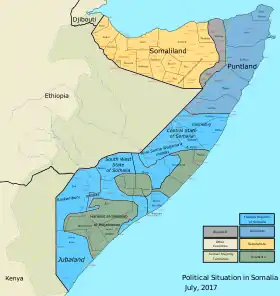
In February 2014, a delegation led by Prime Minister of Somalia Abdiweli Sheikh Ahmed met in Addis Ababa with Ethiopian Prime Minister Hailemariam Desalegn to discuss strengthening relations between the countries. Ahmed commended Ethiopia's role in the ongoing peace and stabilization process in Somalia as well as its opposition to Al-Shabaab, and welcomed the Ethiopian military's decision to join AMISOM. Desalegn in turn pledged his administration's continued support for Somalia's peace and stabilization efforts, as well as its preparedness to assist in initiatives aiming to build up Somali security forces through experience-sharing and training. The meeting concluded with a tripartite Memorandum of Understanding agreeing to promote partnership and cooperation, including a cooperative agreement to develop the police force.[113]
On 5 March 2014, the UN Security Council unanimously voted to extend the partial easing of the arms embargo on Somalia to 25 October.[114] The resolution permitted the Somali government to purchase light weapons, with the stipulation that all member states must take steps to prevent the direct or indirect supply, transfer or sale of arms and military equipment to individuals or entities outside of the Somali security forces.[114][115] The Somali government was also required to routinely report on the structural status of the military, as well as provide information on the extant infrastructure and protocols designed to ensure the military equipment's safe delivery, storage and maintenance.[115]
In early March 2014, AMISOM, supported by Somali militias, launched another operation to remove Al-Shabaab from its remaining areas of control in southern Somalia.[116] According to Prime Minister Abdiweli Sheikh Ahmed, the government subsequently launched stabilization efforts in the newly liberated areas, which included Rab Dhuure, Hudur, Wajid and Burdhubo. The Ministry of Defense provided ongoing reassurance and security to local residents, and supplied logistical and security support. Additionally, the Ministry of Interior was prepared to support and put into place programs to assist local administration and security. A Deputy Minister and several religious scholars were dispatched to all four towns to coordinate and supervise the federal government's stabilization initiatives.[117] By March 26, the allied forces had liberated ten towns, including Qoryoley and El Buur.[118][119] UN Special Representative for Somalia Nicholas Kay described the military advance as the most significant and geographically extensive offensive since AU troops began operations in 2007.[120]
In August 2014, the Somali government-led Operation Indian Ocean was launched, which aimed to clean up the remaining insurgent-held pockets in the countryside.[121] On 1 September 2014, a U.S. drone strike carried out as part of the broader mission killed Al-Shabaab leader Moktar Ali Zubeyr.[122] U.S. authorities hailed the raid as a major symbolic and operational loss for Al-Shabaab, and the Somali government offered a 45-day amnesty to all moderate members of the militant group.
On 15 December 2018 there were demonstrations in the city of Baidoa by supporters of Mukhtar Rowbow, a presidential candidate who had been arrested two days earlier by government forces and transferred to Mogadishu. Rowbow is a senior member of al-Shabaab.[123] AMISOM announced that its forces did not assist in Rowbow's arrest and his transfer to Mogadishu.[124]
As of April 2020, humanitarian researchers and local medical personnel are concerned that the COVID-19 pandemic could be catastrophic for Somalis because of the damage the civil war has wrought on Somalia's health care system.[125] On 25 November 2020, it was reported that a CIA officer had been killed in Somalia. The death came as the US administration under Donald Trump was making plans to withdraw more than 600 troops from Somalia.[126]
President Donald Trump ordered the Department of Defense to remove the majority of the 700 U.S. military troops in Somalia from the country in December 2020. He changed the mission of American troops to assist the local Somali military in its fight against al-Shabab, an al-Qaida affiliated group after losing the 2020 presidential election.[127] "Left unchecked we could see what happened at the Westgate Mall in Kenya in 2015 when 67 civilians were killed by al-Shabab, an affiliate of al-Qaida, happen again. We have reduced their capacity to carry out external attacks, not their willingness," said Mick Mulroy to Politico, the former deputy assistant secretary of Defense and a retired CIA officer who served in Somalia.[127]
Casualties
According to Necrometrics, around 500,000 people are estimated to have been killed in Somalia since the start of the civil war in 1991.[5] The Armed Conflict Location & Event Dataset estimates that 3,300 people were killed during the conflict in 2012,[128] with the number of fatalities dropping slightly in 2013 to 3,150.[128]
See also
Notes
- Various start dates have been offered for when the civil war in Somalia began. The Central Bank of Somalia,[1] the United Nations,[2][3] the US Office of the Secretary of Defense,[4] and Necrometrics all assert that the conflict started in 1991, after the ouster of the Siad Barre administration.[5] Political scientist James Fearon argues that the start of the conflict could be dated to 1981, when armed Isaaq clan militias began to launch small-scale attacks against the Barre regime and its Isaaq members, to the razing of the Isaaq majority town of Hargeisa in 1988 by state forces, or to 1991, following the collapse of the Barre administration and the commencement of interclan warfare. For analytical purposes, he settles on 1991 for the start date of a new civil war, on the grounds that the fighting had begun previously, but that a major party to the conflict was defeated.[6] Robinson writes that the "civil war had effectively begun by 1987", referring to Compagnon.[7]
References
- "Board of Directors". Central Bank of Somalia. Archived from the original on May 18, 2015. Retrieved May 3, 2015.
- "UN senior official calls for widespread support for Somali Government reform efforts" (PDF). United Nations. Archived (PDF) from the original on October 4, 2015. Retrieved May 3, 2015.
- "Somalia - UNOSOM II: Background". United Nations. Archived from the original on January 15, 2017. Retrieved May 3, 2015.
- "Richard B. Cheney - George H.W. Bush Administration". US Office of the Secretary of Defense. Archived from the original on May 18, 2015. Retrieved May 3, 2015.
- "Twentieth Century Atlas – Death Tolls and Casualty Statistics for Wars, Dictatorships and Genocides". Users.erols.com. Archived from the original on April 26, 2011. Retrieved April 20, 2011.
- Fearon, James D. (2004). "Why Do Some Civil Wars Last So Much Longer Than Others?". Journal of Peace Research. 41 (3): 275–301. CiteSeerX 10.1.1.19.3818. doi:10.1177/0022343304043770. S2CID 7158376.
- Robinson, Colin (2016). "Revisiting the rise and fall of the Somali Armed Forces, 1960–2012". Defense & Security Analysis. 32 (3): 237–252. doi:10.1080/14751798.2016.1199122. S2CID 156874430.
- Kenya: Seven Oromo Liberation Front Fighters Held in Garissa Allafrica.com (Daily Nation), January 6, 2007
- https://ahvalnews.com/turkish-military/significance-turkeys-overseas-military-bases
- "US special forces base, Italian army convoy attacked in Somalia". Al Jazeera. September 30, 2019.
- "Al-Shabaab leader's fate unclear after suspected U.S. drone strike". CNN. Archived from the original on June 30, 2015. Retrieved September 2, 2014.
- "U.S. drone strike in Somalia targets al-Shabab leader". The Washington Post. Archived from the original on October 19, 2017. Retrieved September 12, 2017.
- "ISIL's First East African Affiliate Conducts Attacks in Somalia, Kenya". DefenseNews. December 29, 2015.
- "Somalia: Pro-ISIL militants, Al Shabaab clash in deadly Puntland infighting". Garowe Online. December 24, 2015. Archived from the original on January 26, 2016. Retrieved January 28, 2016.
- c.f. UCDP datasets Archived June 28, 2013, at the Wayback Machine for SNA, SRRC, USC, SNM, ARS/UIC and Al-Shabaab tolls.
- UCDP non-state conflict Archived March 4, 2016, at the Wayback Machine tolls
- "UNHCR report: More displaced now than after WWII". Archived from the original on January 20, 2018. Retrieved January 24, 2018.
- Ken Menkhaus, 'Local Security Systems in Somali East Africa,' in Andersen/Moller/Stepputat (eds.) , Fragile States and Insecure People,' Palgrave, 2007, 73. Archived February 22, 2014, at the Wayback Machine
- Legum, Colin (1989). Africa Contemporary Record: Annual Survey and Documents, Volume 20. Africa Research Limited. p. B-394. Archived from the original on January 25, 2015. Retrieved November 12, 2016.
- Bongartz, Maria (1991). The civil war in Somalia: its genesis and dynamics. Nordiska Afrikainstitutet. p. 24. Archived from the original on January 25, 2015. Retrieved November 12, 2016.
- Central Intelligence Agency (2011). "Somalia". The World Factbook. Langley, Virginia: Central Intelligence Agency. Retrieved October 5, 2011.
- Central Intelligence Agency (2011). "Somalia - Government - Judicial branch". The World Factbook. Langley, Virginia: Central Intelligence Agency. Archived from the original on May 19, 2015. Retrieved May 2, 2015.
- Ken Menkhaus, "Local Security Systems in Somali East Africa," Fragile States and Insecure People, 2007, 73.
- Jamal, Ahmad Rashid. "Identifying Causes of State failure: The Case of Somalia". Universität Konstanz Politik- und Verwaltungswissenschaften. Archived from the original on May 22, 2015. Retrieved May 22, 2015.; Fergusson, James (January 13, 2013). "Somalia: A failed state is back from the dead". The Independent. Archived from the original on September 8, 2017. Retrieved May 18, 2015.; Anderson, Jon Lee (December 14, 2009). "The Most Failed State". The New Yorker. Archived from the original on March 28, 2015. Retrieved May 18, 2015.
- Central Intelligence Agency (2003). "Somalia - Government - Judicial branch". The World Factbook. Langley, Virginia: Central Intelligence Agency. Archived from the original on March 4, 2016. Retrieved May 18, 2015.
- In 2007, Menkhaus wrote that 'armed conflict in Somalia has generally subsided since the early 1990s. Armed clashes continue to break out, but are nowhere near the scale and intensity of the fighting that destroyed Hargeisa in 1988–89 or Mogadishu in 1991–92.' Menkhaus, FSIP, 2007, 75.
- Menkhaus 2007, op. cit., 76.
- Messner, J.J. (June 24, 2014). "Failed States Index 2014: Somalia Displaced as Most-Fragile State". The Fund for Peace. Archived from the original on May 4, 2015. Retrieved May 18, 2015.
- "Kenya launches offensive in Somalia". Reuters. October 16, 2011. Archived from the original on January 29, 2013. Retrieved May 2, 2015.
- United Nations Security Council, Report of the Monitoring Group on Somalia and Eritrea pursuant to Security Council Resolution 2002 (2011), S/2012/544, p.226
- "Kenya – KDF". AMIS. Archived from the original on April 2, 2013. Retrieved May 5, 2015.
- "Communiqué on Secretary-General's Mini-Summit on Somalia". United Nations. Archived from the original on October 19, 2013. Retrieved May 18, 2015.
- Balthasar, Dominik (November 19, 2014). "New Approaches Are Needed for State-Building in Somalia". Fair Observer. Archived from the original on June 26, 2015. Retrieved June 26, 2015.
- Messner, J. J. (June 24, 2013). "Failed States Index 2013: What Were You Expecting?". The Fund for Peace. Archived from the original on June 26, 2015. Retrieved June 26, 2015.
- "The European Union announces more than €124 million to increase security in Somalia". European Commissioner. Archived from the original on May 24, 2015. Retrieved May 22, 2015.
- Kay, Nicholas. "Somalia's Year of Delivery". Goobjoog. Archived from the original on April 2, 2015. Retrieved May 22, 2015.
- World of Information (Firm), Africa review, (World of Information: 1987), p.213.
- Arthur S. Banks, Thomas C. Muller, William Overstreet, Political Handbook of the World 2008, (CQ Press: 2008), p.1198.
- National Academy of Sciences (U.S.). Committee on Human Rights, Institute of Medicine (U.S.). Committee on Health and Human Rights, Scientists and human rights in Somalia: report of a delegation, (National Academies: 1988), p.9.
- "Somalia — Government". Library of Congress. Archived from the original on July 4, 2014. Retrieved February 15, 2014.
- Nannini, Vance J. Decisions in Operations Other Than War: The United States Intervention in Somalia.
- Somalia : a country study. Metz, Helen Chapin, 1928-, Library of Congress. Federal Research Division., Thomas Leiper Kane Collection (Library of Congress. Hebraic Section) (4th ed.). Washington, D.C.: Federal Research Division, Library of Congress. 1993. ISBN 0-8444-0775-5. OCLC 27642849.CS1 maint: others (link)
- Menkhaus, Ken (April 2011). "Somalia and the Horn of Africa". World Bank.
- Bloomfield, Steve (June 11, 2007). "Aden Abdulle Osman — First President of Somalia". The Independent. Archived from the original on December 21, 2013. Retrieved December 21, 2013.
- Horn of Africa Bulletin, Volumes 3–4. Life & Peace Institute. 1991. p. 14. Archived from the original on May 19, 2014. Retrieved November 12, 2016.
- Renders, Marleen (January 20, 2012). Consider Somaliland: State-Building with Traditional Leaders and Institutions. BRILL. ISBN 978-90-04-21848-2.
- Walls, Michael (2011). State formation in Somaliland: Bringing deliberation to institutionalism. University College London.
- Walls, Michael (July 1, 2009). "The Emergence of a Somali State: Building Peace from Civil War in Somaliland". African Affairs. 108 (432): 371–389. doi:10.1093/afraf/adp019. ISSN 0001-9909.
- Drysdale, John Gordon Stewart (1991). Somaliland 1991: Report and Reference. Global-Stats.
- Adam, Hussein (1998). Somalia: Personal Rule, Military Rule and Militarism (in) Hutchful and Bathily, The Military and Militarism in Africa. Dakar: Council for the Development of Economic and Social Research in Africa (CODESRIA). p. 389. ISBN 978-2-86978-069-9.
- Nina J. Fitzgerald, Somalia: issues, history, and bibliography, (Nova Publishers: 2002), p.19.
- Ciisa-Salwe, Cabdisalaam M. (1996). The collapse of the Somali state: the impact of the colonial legacy. HAAN Publishing. p. 104. ISBN 978-1874209911. Archived from the original on April 15, 2015. Retrieved November 12, 2016.
- Silanyo, Ahmed M. "A Proposal to the Somali National Movement: On a Framework for a Transitional Government in Somalia" (PDF). Wardheernews. Archived from the original (PDF) on May 11, 2012. Retrieved February 15, 2014.
- Library Information and Research Service, The Middle East: Abstracts and index, Volume 2, (Library Information and Research Service: 1999), p.327.
- Interpeace, 'The search for peace: A history of mediation in Somalia since 1988,' Interpeace, May 2009, 13–14. Archived February 22, 2014, at the Wayback Machine
- Clancy, Tom; Tony Zinni; Tony Koltz (2005). Battle Ready:Study in Command Commander Series. Penguin. pp. 234–236. ISBN 978-0-425-19892-6.
- Mohamed Ahmed Jama, “Securing Mogadishu: Neighbourhood Watches,” in Whose Peace is it anyway? Connecting Somali and International Peacemaking Approaches, Accord 21, Conciliation Resources, 2010, 66.
- Ken Rutherford, Humanitarianism Under Fire: The US and UN Intervention in Somalia, Kumarian Press, July 2008 ISBN 1-56549-260-9
- "United Nations Operation In Somalia I – (Unosom I)". United Nations. Archived from the original on April 8, 2011. Retrieved January 29, 2012.
- For further details on UNOSOM-sponsored local-level community-based reconciliation conferences, see Menkhaus, 'International Peacebuilding and the Dynamics of Local and National Reconciliation in Somalia,' International Peacekeeping, Vol. 3, No. 1, Spring 1996, 52.
- See also Report of the Secretary-General on Somalia, S/1995/231 (March 28, 1995).
- "Report of the Secretary-General on the Situation in Somalia (S/1996/42)" (PDF). January 19, 1996. Archived (PDF) from the original on February 22, 2014. Retrieved February 14, 2014., page 2, paragraph 7.
- Djibouti Conference Archived March 16, 2012, at the Wayback Machine.
- Associated Press (September 19, 1995). "Aidid troops kill Somalis, capture city". The Register-Guard. Archived from the original on September 11, 2015. Retrieved May 16, 2013.
- S/1996/42, 26, 27, 28, 29
- Report of the Secretary-General on the Situation in Somalia, S/1997/135, February 17, 1997, paragraphs 6,7, and 9. For later occurrences 1997 to 2000, see S/1997/715, S/1999/882, and S/2000/1211 (December 19, 2000).
- Somalia: Puntland's Experience in Peace-building and State-building
- "Somalia: IRIN interview with Hussein Aideed, 5/4/99". IRIN. Archived from the original on March 4, 2016. Retrieved April 19, 2014.
- Strategic Survey 1999-2000, 264.
- "August 2000 – Somalia". Rulers. Archived from the original on October 29, 2013. Retrieved October 6, 2013.
- Interpeace, 'The search for peace: A history of mediation in Somalia since 1988,' Interpeace, May 2009, 59-60
- Interpeace, May 2009, 60-61.
- "Ethiopian Invasion of Somalia". Globalpolicy.org. August 14, 2007. Archived from the original on September 10, 2009. Retrieved June 27, 2010.
- "Profile: Somali's newly resigned President Abdullahi Yusuf Ahmed". News.xinhuanet.com. December 29, 2008. Archived from the original on November 15, 2013. Retrieved September 5, 2013.
- Ken Menkhaus, 'Somalia: What went wrong?' The RUSI Journal, Vol. 154, No. 4, August 2009, 8. Menkhaus says in addition: '[f]or details, see Human Rights Watch, 'Shell-shocked: Civilians under siege in Mogadishu,' Archived September 17, 2014, at the Wayback Machine August 13, 2007, and HRW, 'So Much to Fear: War Crimes and the Devastation of Somalia,' December 2008.'
- Interpeace, May 2009, 61.
- Wezeman, Pieter D. "Arms flows and conflict in Somalia" (PDF). SIPRI. Archived from the original (PDF) on June 2, 2013. Retrieved February 10, 2014.
- "Background and Political Developments". AMISOM. Archived from the original on August 21, 2011. Retrieved February 11, 2014.
- "Hardline Islamist Militia Group Shabbab Emerges in Somalia". Jamestown Foundation. August 8, 2006. Archived from the original on October 10, 2008.
- International Crisis Group, Somalia: To Move Beyond the Failed State, Africa Report N°147 – December 23, 2008, 25.
- "USCIRF Annual Report 2009 – The Commission's Watch List: Somalia". USCIRF. Archived from the original on February 22, 2014. Retrieved February 15, 2014.
- "Somalia: Guide to Puntland Election 2009". Garoweonline.com. December 25, 2008. Archived from the original on May 14, 2011. Retrieved June 12, 2011.
- "Opening Annual General Assembly Debate, Secretary-General Urges Member States to Press in Tackling Poverty, Terrorism, Human Rights Abuses, Conflicts". Unis.unvienna.org. Archived from the original on May 11, 2011. Retrieved June 12, 2011.
- "Somalia's president quits office" Archived January 24, 2012, at the Wayback Machine, BBC News, December 29, 2008.
- "Somali President Yusuf resigns" Archived December 31, 2008, at the Wayback Machine, Reuters (FT.com), December 29, 2008.
- Kamaal says (May 22, 2010). "UN boss urges support for Somalia ahead of Istanbul summit". Horseedmedia.net. Archived from the original on June 19, 2010. Retrieved June 27, 2010.
- "Islamists break Somali port truce". BBC News. October 21, 2009. Archived from the original on October 26, 2009. Retrieved June 27, 2010.
- Shariah in Somalia Archived September 22, 2012, at the Wayback Machine – Arab News
- Online, Garowe (January 12, 2011). "Somalia President, Parliament Speaker dispute over TFG term". Garoweonline.com. Archived from the original on May 14, 2011. Retrieved June 12, 2011.
- "Security Council Meeting on Somalia". Somaliweyn.org. Archived from the original on January 5, 2014.
- "Al-Shabaab Evicted from Mogadishu". Somalia Report. Archived from the original on February 22, 2014. Retrieved February 14, 2014.
- Chothia, Farouk (August 9, 2011). "Could Somali famine deal a fatal blow to al-Shabab?". BBC. Archived from the original on April 10, 2018. Retrieved June 22, 2018.
- "Kenya launches offensive in Somalia". National Post. Reuters. October 16, 2011. Archived from the original on January 29, 2013. Retrieved February 15, 2014.
- "Joint Communique – Operation Linda Nchi". Kenya High Commission, Tanzania. Archived from the original on August 16, 2012. Retrieved September 25, 2013.
- "Somalia government supports Kenyan forces' mission". Standardmedia.co.ke. Archived from the original on March 14, 2012.
- Azikiwe, Abayomi (January 4, 2012). "Leaked cables confirm U.S. role in Somalia war". Pan-African News Wire. Archived from the original on February 22, 2014. Retrieved February 16, 2014.
- Anderson, David; McKnight, Jacob (2015). "Kenya at war: Al-Shabaab and its enemies in Eastern Africa". African Affairs. 114 (454): 1–27. doi:10.1093/afraf/adu082.
- "Kenya: Defense Minister appointed as acting Internal Security Minister". Garowe Online. June 19, 2012. Retrieved June 20, 2012.
- Chonghaile, Clar Ni (September 28, 2012). "Kenyan troops launch beach assault on Somali city of Kismayo". The Guardian. Archived from the original on September 29, 2013. Retrieved September 28, 2012.
- "United Nations Security Council Resolution 2093". Archived from the original on April 10, 2019. Retrieved April 25, 2019. S/RES/2093 (2013), March 6, 2013
- Hammond, Laura (2013). "Somalia rising: things are starting to change for the world's longest failed state". Journal of Eastern African Studies. 7 (1): 183–193. doi:10.1080/17531055.2012.755316. S2CID 154479105.
- "U.S. military advisers deployed to Somalia to help African forces". Reuters. January 10, 2014. Archived from the original on September 24, 2015. Retrieved February 17, 2014.
- Martinez, Luis (January 10, 2014). "U.S. Military Advisers Deployed to Somalia: First Time Since Blackhawk Down". ABC News. Archived from the original on January 12, 2014. Retrieved January 12, 2014.
- Tekle, Tesfa-Alem (November 12, 2013). "Somalia: Ethiopia Decides to Join Amisom Force in Somalia". Sudan Tribune. Archived from the original on January 13, 2014. Retrieved January 12, 2014.
- Ali, Hassan (November 12, 2013). "Somali government welcomes Ethiopia AMISOM integration". Dalsan Radio. Archived from the original on December 2, 2013. Retrieved February 16, 2014.
- "Comment on Ethiopian troops formally join AMISOM peacekeepers in Somalia". Foreign Affairs. February 14, 2014. Archived from the original on February 21, 2014. Retrieved February 16, 2014.
- "Ethiopian Forces formally integrated into AMISOM". AMISOM. Archived from the original on March 30, 2014. Retrieved February 14, 2014.
- "Mohamud wants UN to extend weapons purchasing mandate". Sabahi. January 31, 2014. Archived from the original on February 21, 2014. Retrieved February 17, 2014.
- "Somalia diverting arms to al-Shabab, UN report claims". BBC News. February 14, 2014. Archived from the original on February 16, 2014. Retrieved February 17, 2014.
- "Somali Government official denies U.N arms diversion allegations". Horseed Media. February 15, 2014. Archived from the original on February 16, 2014. Retrieved February 17, 2014.
- "Federal government of Somalia denies the report issued by UN monitoring group". Goobjoog. February 15, 2014. Archived from the original on February 22, 2014. Retrieved February 17, 2014.
- "SOMALIA: Military chief says UN Monitoring Group wants Al Shabab to become an endless project". Raxanreeb. February 17, 2014. Archived from the original on February 22, 2014. Retrieved February 18, 2014.
- "Ethiopia: The Prime Minister of Somalia On a Visit to Ethiopia". Government of Ethiopia. Archived from the original on February 22, 2014. Retrieved February 17, 2014.
- "UN Security Council Extends Arms Embargo lift on Somalia to eight months". Horseed Media. March 6, 2014. Archived from the original on January 13, 2016. Retrieved March 6, 2014.
- Charbonneau, Louis (March 6, 2014). "U.N. extends partial easing of Somalia arms embargo to October". Reuters. Archived from the original on September 24, 2015. Retrieved March 6, 2014.
- "Somalia: Federal Govt, AMISOM troops clash with Al Shabaab". Garowe Online. March 11, 2014. Archived from the original on March 11, 2014. Retrieved March 11, 2014.
- "SOMALIA: PM hosts meeting with International Community diplomats on stabilisation efforts". Raxanreeb. March 12, 2014. Archived from the original on March 12, 2014. Retrieved March 12, 2014.
- "SOMALIA: The capture of Qoryooley is critical for the operations to liberate Barawe, Amisom head says". Raxanreeb. March 22, 2014. Archived from the original on March 22, 2014. Retrieved March 23, 2014.
- "SOMALIA: Elbur town falls for Somali Army and Amisom". Raxanreeb. March 26, 2014. Archived from the original on March 26, 2014. Retrieved March 26, 2014.
- "Somalia, AU troops close in on key Shebab base". AFP. March 22, 2014. Archived from the original on March 23, 2014. Retrieved March 23, 2014.
- "SOMALIA: President says Godane is dead, now is the chance for the members of al-Shabaab to embrace peace". Raxanreeb. September 5, 2014. Archived from the original on September 6, 2014. Retrieved September 6, 2014.
- "Pentagon Confirms Death of Somalia Terror Leader". Associated Press. September 5, 2014. Archived from the original on September 6, 2014. Retrieved September 6, 2014.
- "US Says Airstrike in Somalia Killed 8 Militants". Archived from the original on December 18, 2018. Retrieved December 17, 2018.
- "AU force in Somalia says not involved in ex-al-Shabaab arrest". Archived from the original on December 18, 2018. Retrieved December 17, 2018.
- Kleist, Nauja; Edle Ali, Abdirahman; Musa, Ahmed; Hassan, Mohammed Aden; Bradbury, Mark (April 1, 2020). "COVID-19: A Looming humanitarian disaster for Somali East Africa". Diaspora Humanitarianism in Complex Crises. Danish Institute for International Studies. Retrieved April 1, 2020.
- Correspondent, Jim Sciutto, Chief National Security. "CIA officer killed in combat in Somalia". CNN. Retrieved November 26, 2020.
- https://abcnews.go.com/Politics/trump-orders-us-troops-somalia/story?id=74546220
- "Conflict Trends (No. 23) Real-time Analysis of African Political Violence, February 2014" (PDF). ACLED. Archived (PDF) from the original on March 16, 2014. Retrieved March 16, 2014.
Further reading
- Afyare Abdi Elmi. Understanding the Somalia conflagration: Identity, political Islam and peacebuilding. Pluto Press, 2010.
- Barnes, Cedric, and Harun Hassan. "The rise and fall of Mogadishu's Islamic Courts". Journal of Eastern African Studies 1, no. 2 (2007): 151–160.
- Bøås, Morten. "Returning to realities: a building-block approach to state and statecraft in Eastern Congo and Somalia". Conflict, Security & Development 10, no. 4 (2010): 443–464.
- I. M. Lewis. A Modern History of the Somali: Nation and State in the Horn of Africa, Athens: Ohio University Press, 2002, ISBN 978-0-8214-1495-8.
- Jutta Bakonyi. "Authority and administration beyond the state: local governance in southern Somalia, 1995–2006", Journal of Eastern African Studies, Vol. 7, Issue 2, 2013.
- Ken Menkhaus. Somalia: State collapse and the threat of terrorism. Adelphi Papers No. 364, Routledge, 2008.
- McGregor, Andrew. "The Leading Factions Behind the Somali Insurgency". Terrorism Monitor, Volume V, Issue 8, April 26, 2007.
External links
| Wikimedia Commons has media related to Somali Civil War. |
- Somalia's Struggle for Stability from The NewsHour with Jim Lehrer
- Somali – U.S. Relations from the Dean Peter Krogh Foreign Affairs Digital Archives
- Somalia Operations: Lessons Learned by Kenneth Allard (CCRP, 1995)
- "Preserving American Security Ties to Somalia," by Michael Johns, The Heritage Foundation, December 26, 1989.
- Changed Arab attitudes to Somalia Conflict
- Security Council Report, United Nations Sanctions Committee on Somalia: Documents
.svg.png.webp)
